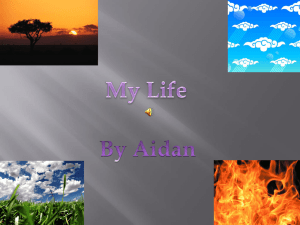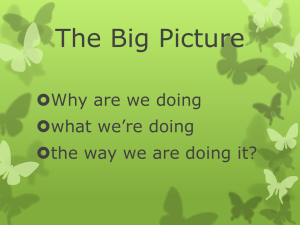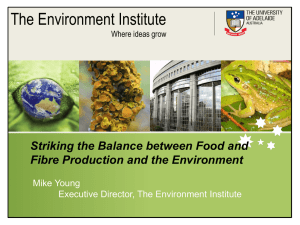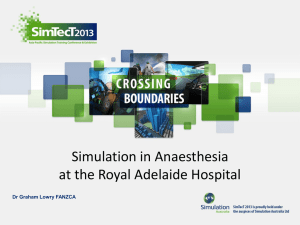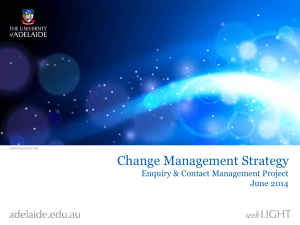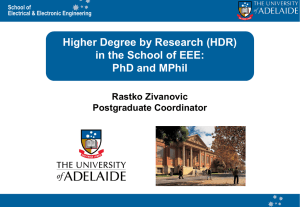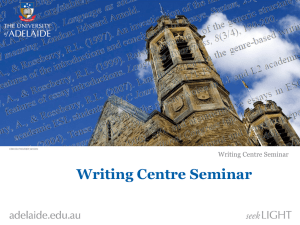Essay Writing: What you need to know ppt
advertisement
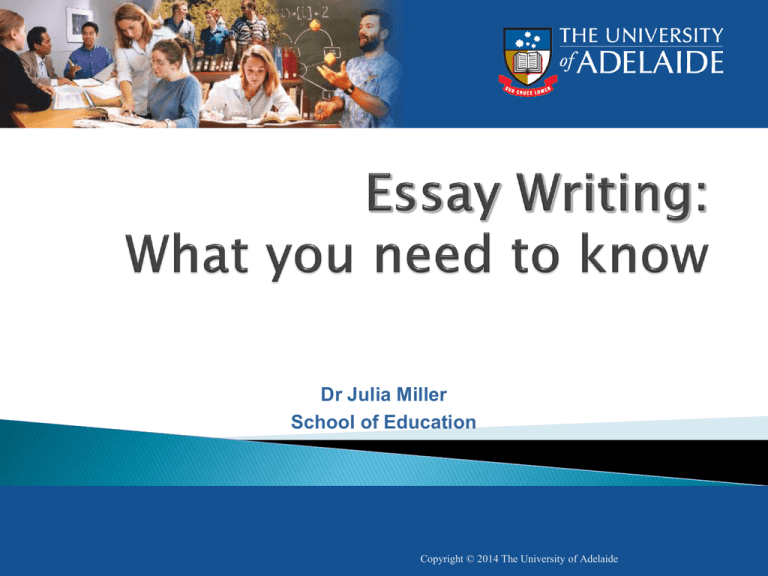
Dr Julia Miller School of Education Copyright © 2014 The University of Adelaide Photo from stock.xchng The University of Adelaide Slide 2 The University of Adelaide Slide 3 Session outline 1. What is an essay? 2. Why do we do essays? 3. How do I approach an essay? 4. What does an essay look like? 5. How is an essay marked? 6. What is referencing? 7. What is critical thinking? 8. What if I can’t finish in time? 9. Where can I go to improve my writing? The University of Adelaide Slide 4 What is the purpose of a university? ‘Studying at the University of Adelaide means being part of a rich tradition of excellence in education and research, with world-class academic staff and a vibrant student life.’ ‘We are committed to producing graduates recognised worldwide for their creativity, knowledge and skills, as well as their culture and tolerance. Our graduates make an impact on the world.’ http://www.adelaide.edu.au/uni/ The University of Adelaide Slide 5 Count your score for the quiz questions on the following slides. The University of Adelaide Slide 6 a) A collection of facts b) A short piece of writing about a particular subject c) A story d) Another word for a report Correct answer: b (taken from the Longman dictionary of contemporary English 2003, p. 531) The University of Adelaide Slide 7 Formal Coherent Connected Structured Persuasive Referenced The University of Adelaide Slide 8 It’s looooooonger . . . ◦ IELTS essays are about 250 words Photo from stock.xchng ◦ university essays vary from 1000 to 5000+ words It doesn’t follow a formula It’s based on research ◦ IELTS asks you to ‘include any relevant examples from your own knowledge or experience’ (http://www.ielts.org/test_takers_information/test_sample.aspx) It includes references, in the text and in a reference list at the end The University of Adelaide Slide 9 a) Because the lecturers like to torture us b) Because exams are no longer in fashion c) Because essays allow us to demonstrate our knowledge d) Because lecturers like marking them Correct answer: c The University of Adelaide Slide 10 Don’t we have to agree with all the literature? Can’t we just write what the lecturers tell us? Can’t we just do an exam with multiple choice answers? No The University of Adelaide Slide 11 ‘We are committed to producing graduates recognised worldwide for their creativity, knowledge and skills, as well as their culture and tolerance. Our graduates make an impact on the world’. http://www.adelaide.edu.au/uni/ The University of Adelaide Slide 12 3. What is the first thing to do when you approach an essay? a) Go to the library and start reading b) Start writing immediately c) Keep calm and carry a big stick d) Analyse the question Correct answer: d Image from zookyworld.wordpress.com The University of Adelaide Slide 13 If all else fails, read the instructions! Actually, read the instructions first! What do you have to do? Discuss, compare, critique . . . How many words should you write? Photo from stock.xchng The University of Adelaide Slide 14 How should I approach an essay? What are the question words? How accurate . . .? How well . . .? Can and should . . .? Do you understand the key words? What is your response to the question? Why do you think that? Response to question + reasons for response = conclusion The University of Adelaide Slide 15 Brainstorm Mind Map The University of Adelaide Slide 16 Read the abstract or first paragraph Next apply a reading strategy Can you put the strategies in the correct order and match them to the meanings? a) Note 1. Look quickly to get a general idea b) Predict the content 2. Read the useful sections in more detail c) Scan 3. Write down important information d) Skim 4. Look for specific words and information e) Analyse some sections 5. Look at the title and work out the content The University of Adelaide Slide 17 Can you match the meanings to the strategies and put them in the correct order? b) Predict 5. Look at the title and work out the content d) Skim 1. Look quickly to get a general idea c) Scan 4. Look for specific words and information e) Analyse 2. Read the useful sections in more detail a) Note 3. Write down important information The University of Adelaide Slide 18 How do I know what to read? Where can I find material? ◦ library ◦ research librarian ◦ databases ◦ Google scholar What kind of sources should I use? The University of Adelaide Slide 19 Is this an academic source? (1) a or b – yes; c or d - no The University of Adelaide Slide 20 Is this an academic source? (2) a or b – yes; c or d - no The University of Adelaide Slide 21 Is this an academic source? (3) a or b – yes; c or d - no The University of Adelaide Slide 22 Is this an academic source? (4) a or b – yes; c or d - no The University of Adelaide Slide 23 Is this an academic source? (5) a or b – yes; c or d - no The University of Adelaide Slide 24 Look at the: author sponsor (e.g. company) publisher website appearance (e.g. adverts) methodology references The University of Adelaide Slide 25 1. __________ (about 10%) 2. _________ Body points 3. _________ (about 10%) 4. __________ The University of Adelaide Slide 26 1. a. Referencelist b. Introduction c. Conclusion d. Thesis statement The University of Adelaide Slide 27 1. Introduction 2. a. Referencelist b. Introduction c. Conclusion d. Thesis statement The University of Adelaide Slide 28 1. Introduction 2. Thesis statement a. Referencelist b. Introduction c. Conclusion d. Thesis statement 3. The University of Adelaide Slide 29 1. Introduction 2. Thesis statement a. Referencelist b. Introduction c. Conclusion d. Thesis statement 3. Conclusion 4. The University of Adelaide Slide 30 Introduction (about 10%) Thesis statement Body points Conclusion (about 10%) Reference list The University of Adelaide Slide 31 Each paragraph should make only one main point. It should include a topic sentence. e.g. Many people like dark chocolate because it is not too sweet. If possible, link your paragraphs in the first sentence. e.g. Although milk chocolate is probably the most popular, many people like dark chocolate because it is not as sweet. The University of Adelaide Slide 32 Course Reader A collection of book chapters and journal articles compiled by the course convenor. A reader is compiled by the course convenor in order to provide the basic reading material for your course. They are available from the university bookshop. (Abbreviated from: University of New South Wales 2007, First steps: a beginner’s guide to University, viewed 1 March 2007, <http://www.lc.unsw.edu.au/firststeps/prep_glossary.html>.) The University of Adelaide Slide 33 Essays Address a question or topic, with many forms of question Have an introduction, body paragraphs and conclusion, ideally with a flow of ideas Reports Usually investigate a specific issue or problem Provide information used to make decisions or take further action Contain an executive summary, recommendations and possibly appendices Have distinct, numbered sections with headings and sub-headings The University of Adelaide Slide 34 Article reviews One article Summary Critique The University of Adelaide Slide 35 Use several sources to talk about a topic or show a gap in the literature on a topic Form a chapter in a thesis The University of Adelaide Slide 36 Content Structure (introduction, body, conclusion) Clarity of ideas Cohesion (how the ideas are linked) Language Referencing The University of Adelaide Slide 37 The University of Adelaide Slide 38 What percentage do you need to get a distinction? a) 85 – 100 % b) 75 – 84 % c) 65 – 74 % d) 50 – 64 % e) 1 – 49 % The University of Adelaide Slide 39 High distinction Distinction Credit Pass Fail 85 – 100 % 75 – 84 % 65 – 74 % 50 – 64 % 1 – 49 % The University of Adelaide Slide 40 6. What is referencing? Referencing means you give the details of any source you have used in your essay. Do you reference quotes? Do you reference ideas? Do you reference paraphrases? Yes, reference any source you have used. The University of Adelaide Slide 41 The University of Adelaide Slide 42 i. presenting work that is not your own in any format, without appropriate attribution or reference to the original source. ii. paraphrasing or copying work that is not your own, without due acknowledgement by way of reference to the original work. iii. adopting the ideas of others, or the structure of an existing analysis, without due acknowledgement by way of reference to the original source. The work of others may be submitted only when use of the work is appropriate and duly acknowledged. (University of Adelaide Honesty Policy 2012) The University of Adelaide Slide 43 In the text; or Sometimes in the footnotes at the bottom of the page; and In a reference list at the end. There are many different referencing styles. Check which one is used in each of your subjects. The University of Adelaide Slide 44 In-text Boynton (1982, p.47) suggests that carrots may be ‘a catalyst to weight-gain when chocolate is present’. It has been suggested (Boynton 1982, p.47) that if someone has already eaten chocolate, then eating carrots later may cause that person to put on weight. The University of Adelaide Slide 45 National Biodiesel Board, Environmental safety and information, viewed 21 August, <www.biodiesel.org/pdf_files/Envi&Safetyinfo.pdf>. Agarwal, AK & Das, LM 2001, ‘Biodiesel development and characterization for use as a fuel in compression ignition engines’, Journal of Engineering for Gas Turbines and Power, vol. 123, no. 2, pp. 440-447. G Rosner 1996, Diesel fuel and exhaust emissions, World Health Organization, Geneva. Demirbas, A 2005, ‘Biodiesel production from vegetable oils via catalytic and non-catalytic supercritical methanol transesterification methods’, Progress in Energy and Combustion Science, vol. 31, no. 5, pp. 466-487. The University of Adelaide Slide 46 Agarwal, AK & Das, LM 2001, ‘Biodiesel development and characterization for use as a fuel in compression ignition engines’, Journal of Engineering for Gas Turbines and Power, vol. 123, no. 2, pp. 440-447. Demirbas, A 2005, ‘Biodiesel production from vegetable oils via catalytic and non-catalytic supercritical methanol transesterification methods’, Progress in Energy and Combustion Science, vol. 31, no. 5, pp. 466-487. National Biodiesel Board 2006, Environmental safety and information, viewed 21 August 2006, <www.biodiesel.org/pdf_files/Envi&Safetyinfo.pdf>. Rosner, G 1996, Diesel fuel and exhaust emissions, World Health Organization, Geneva. The University of Adelaide Slide 47 You write the text You write the arguments in your own words You give a reference for every idea from another source You incorporate those ideas into your own writing The University of Adelaide Slide 48 7. What is critical thinking? Critical thinking means: You think for yourself You do not necessarily agree with a reading You ask questions You solve problems You look at the evidence The University of Adelaide Slide 49 Fact - something which is known to have happened or to exist, especially something for which proof exists, or about which there is information Opinion - a thought or belief about something or someone Assumption - something that you accept as true without question or proof (All definitions from Cambridge University Press 2011, Cambridge dictionaries online, viewed 15 February 2012, <http://dictionary.cambridge.org>.) The University of Adelaide Slide 50 All international students have a lot of money and do not need to have a job. Fact International students often speak English very well. Opinion All international students should have an IELTS score of 8 to enter university in Australia. Assumption All Chinese students are international students. The University of Adelaide Slide 51 Can you think critically? English is the main language spoken in Australia. Fact If someone lives in Australia, that means they are able to Assumption speak English. All people who live in Australia should speak English. The University of Adelaide Opinion Slide 52 a) A man appeared after the owner had turned off his store lights. b) The robber was a man. c) Someone opened a cash register. d) The man who appeared did not demand money. Which statement is true? The University of Adelaide Slide 53 Assessing a source Compare: Leite (2007) shows that most people prefer white chocolate to milk or dark chocolate. Leite’s study (2007) claims that people prefer white chocolate to milk or dark chocolate. His research, however, is limited, as his sample size consisted of only five small children in Portugal. It is therefore more realistic to consider the implications of Brown’s study (2009), which found that in a sample of ten thousand adults from France, Germany, China, the United States and Mexico 65% preferred milk chocolate and 30% preferred dark chocolate, while only 5% preferred white chocolate. This suggests . . . The University of Adelaide Slide 54 How do I know if it's useful information or a reliable source? Here is a good example to help you think critically about your sources: http://www.nhs.uk/news/2009/11November /Pages/chocolate-mental-health-cut-stressclaim.aspx The University of Adelaide Slide 55 8. What if I can't finish in time? Are you trying to write too much? Did you have trouble finding sources? Were you ill? Are you having trouble doing all your work? The University of Adelaide Slide 56 Can't finish in time? Ask for an extension Reconsider your priorities - How much do you earn in your part-time job? - What will it cost if you have to retake a topic? Look at your time management – try the Assignment Planning Calculator Talk to your course coordinator The University of Adelaide Slide 57 25+ points You’re an essay expert! Would you like to give this lecture next time? 20-24 points Well done! You have lots of great essay writing ideas. 15-19 points Good. There are still a few things for you to work on, though. 8-13 points I hope this lecture was helpful – you still have quite a lot to learn. 0 – 8 points What a good thing you came today! The University of Adelaide Slide 58 Writing Centre, Hub Central. Monday – Friday, 10 am – 4 pm http://www.adelaide.edu.au/writingcentre The English for Uni website http://www.adelaide.edu.au/english-foruni/essay-writing/ The University of Adelaide Slide 59 The University of Adelaide Slide 60 For further thought Write down 2 things you really need to remember from this session. Is anything still unclear? The University of Adelaide Slide 61 Have a great year! The University of Adelaide Slide 62
